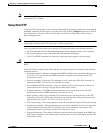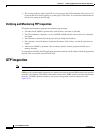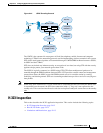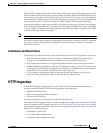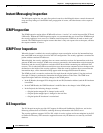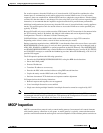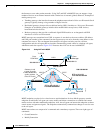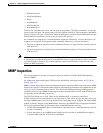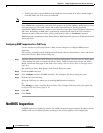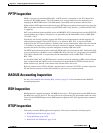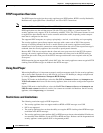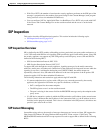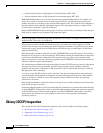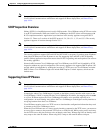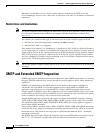
24-17
Cisco ASDM User Guide
OL-16647-01
Chapter 24 Configuring Application Layer Protocol Inspection
MMP Inspection
• DeleteConnection
• NotificationRequest
• Notify
• AuditEndpoint
• AuditConnection
• RestartInProgress
The first four commands are sent by the call agent to the gateway. The Notify command is sent by the
gateway to the call agent. The gateway may also send a DeleteConnection. The registration of the MGCP
gateway with the call agent is achieved by the RestartInProgress command. The AuditEndpoint and the
AuditConnection commands are sent by the call agent to the gateway.
All commands are composed of a Command header, optionally followed by a session description. All
responses are composed of a Response header, optionally followed by a session description.
• The port on which the gateway receives commands from the call agent. Gateways usually listen to
UDP port 2427.
• The port on which the call agent receives commands from the gateway. Call agents usually listen to
UDP port 2727.
Note MGCP inspection does not support the use of different IP addresses for MGCP signaling and RTP data.
A common and recommended practice is to send RTP data from a resilient IP address, such as a loopback
or virtual IP address; however, the security appliance requires the RTP data to come from the same
address as MGCP signalling.
MMP Inspection
The security appliance includes an inspection engine to validate the CUMA Mobile Multiplexing
Protocol (MMP).
For information about setting up the TLS Proxy for the Mobility Advantage feature, see TLS Proxy
Wizard, page 19-17.
MMP is a data transport protocol for transmitting data entities between CUMA clients and servers. MMP
must be run on top of a connection-oriented protocol (the underlying transport) and is intended to be run
on top of a secure transport protocol such as TLS. The Orative Markup Language (OML) protocol is
intended to be run on top of MMP for the purposes of data synchronization, as well as the HTTP protocol
for uploading and downloading large files.
The TCP/TLS default port is 5443. There are no embedded NAT or secondary connections.
CUMA client and server communications can be proxied via TLS, which decrypts the data, passes it to
the inspect MMP module, and re-encrypt the data before forwarding it to the endpoint. The inspect MMP
module verifies the integrity of the MMP headers and passes the OML/HTTP to an appropriate handler.
The security appliance takes the following actions on the MMP headers and data:
• Verifies that client MMP headers are well-formed. Upon detection of a malformed header, the TCP
session is terminated.
• Verifies that client to server MMP header lengths are not exceeded. If an MMP header length is
exceeded (4096), then the TCP session is terminated.



